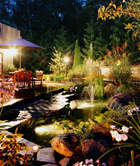Roof gardens are now becoming popular because of the limited space in most cities. Gardening relieves stress, such that many people would even settle for roof gardens to keep this hobby.
 A roof garden is a type of garden situated on a roof of a building. Ever since, humans have developed a fondness to growing plants on top of structures. Aside from the decorative benefits, these roof plantings actually provide temperature control, food, and habitats for wildlife, along with recreational opportunities and architectural enhancement. In certain cities, due to the lack of gardening areas, many resort to roof gardens.
A roof garden is a type of garden situated on a roof of a building. Ever since, humans have developed a fondness to growing plants on top of structures. Aside from the decorative benefits, these roof plantings actually provide temperature control, food, and habitats for wildlife, along with recreational opportunities and architectural enhancement. In certain cities, due to the lack of gardening areas, many resort to roof gardens.
This type of garden can be on top of building, taking care of its own waste and water supply. With hydroponics, and other methods, you are able to expand the numerous possibilities of gardening on roof tops. A good way to accomplish this is by reducing the tremendous weight or soil needed. This is why planting in containers are prevalent in these gardens. Pots may be too heavy for the roof and cause ceilings to leak.
Living in small-sized apartments should not hinder you from having a garden. You can have vertical gardening or square foot gardening. Vertical gardening is planting with the use of your living walls. It uses lesser space than the traditional square foot gardening method.
Before starting, it is important to till, weed, and eliminate any pests. Also recycle by composting. In fact, for small apartments, having a Bokashi type of compost system is far more practical as compared to conventional composting. The safest type of compost is the manure derived from vegetarian animals.
In this busy world, most people find solace from nature. If you are too tired to take strolls in the park and you cannot go to nature trails all the time, having a garden at home, specifically in your terrace is the best solution to this dilemma. Hence, terrace gardening is a kind of indoor gardening that entails taking care of indoor plants.
Follow some tips in roof gardening. Your roof needs to be strong enough to carry the gardens weight. Also check for an efficient drainage system. And lastly, make sure there are no water leaks.
For terrace gardening, keep proportional the shrubs, lawns, small trees and ground covers. You can also enliven your garden corner with rocks and other naturalistic designs.
After this, you need to choose the kinds of plants you want. Fiber-rooted plants are better than tap-rooted plants. This is because tap-rooted plants can grow into the building and harm the structure.
For the soil, get the type that will not exert pressure onto your building. Peat moss and soil rite are good options. Since these are a bit expensive, you can mix it with manure and garden earth.
 To arrange your drainage system, it is imperative that you do your roof garden construction. You can uniformly lay 2-inch to 4-inch burnt bricks on your terrace. This type of bricks is the best because the normal ones eventually turn into mud and consequently collapse the drainage system. A good alternative are corrugated sheets which needs to be placed on 3 inch distances, making the water freely flow onto the drain.
To arrange your drainage system, it is imperative that you do your roof garden construction. You can uniformly lay 2-inch to 4-inch burnt bricks on your terrace. This type of bricks is the best because the normal ones eventually turn into mud and consequently collapse the drainage system. A good alternative are corrugated sheets which needs to be placed on 3 inch distances, making the water freely flow onto the drain.
On top of these bricks, you need to place a net lawn. This prevents your soil from getting into the bricks. If your garden is a bit large, you need to have a drain constructed in several places. You should also place some pipes along several areas that would lead to the main holes. Make sure that these pipes are not visible. Keep in hidden beneath the lawn.
Lastly, place the soil mixture you prepared into the pot or any container. These gardens will beautify your home, and also promote a healthier environment.
Article by David H Urmann










Join the Discussion
Type out your comment here:
You must be logged in to post a comment.